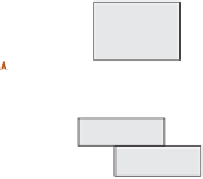Geoscience Reference
In-Depth Information
azonal. Details of form or intensity which reflect climatic
nuances do not override this principle. No one doubts the
role of climate in contributing materials (water, ice, air,
pollutants) in particular amounts and regimes to the
geomorphic environment, or of temperature and mois-
ture, etc., in influencing processes. To regard it as
dominant or controlling is inappropriate, however: it
ignores the role of geological factors and misunderstands
the nature of
process
.
Force
and
resistance
hold the key to the progressive
breakdown of intact rock and therefore denudation.
Forces applied to rock mass originate
internally
through
volumetric changes associated with heating, cooling,
chemical reactions and the circulation of fluids (including
air). They determine
rock weathering
processes. Forces are
also applied
externally
, through the emplacement and/or
removal of static (
in situ
) or dynamic (moving) loads
of rock, sediment, water, ice, wind or anthropogenic
structures. This is the essence of erosion. The latter include
tectonic forces whose effects are represented by elastic
strain, released in earthquakes, deformation structures
and continuing rock deformation. Resistance can be
measured as hardness, resisting
abrasion
, or as the sum of
internal strength properties capable of resisting
tensile
stress
(pull apart),
compressive stress
(crushing) and
shear stress
(sliding rupture) (
Figure 13.4
).
Abrasion
occurs when one rock scratches another of lower hardness.
It is a minor process in slope and glacial environments
(
striation
) and in-transit sediments, where
attrition
polishes grains jostled together. Some forms of weathering
establish internal tensile stress where individual minerals
expand.
Tensile and compressive stresses are more directly
important to tectonic than geomorphic processes.
Together with shear stress, they drive deformation and
uplift and are therefore instrumental in initiating
denudation. However, the inherited effect of deforma-
tion in the form of rock structures is of profound
geomorphic significance. All forms of structure - folds,
fractures, faults, thrusts, joints, laminations, etc. - regard-
less of their lithological or tectonic origin, are
planar
discontinuities
which render rock mass mechanically and
hydraulically defective. That is, individually they represent
two-dimensional, planar partings where the homo-
geneous character of a rock mass, especially its cohesive
or
intact strength
, is momentarily interrupted or lost.
There are a number of key geomorphic consequences.
They control the
permeability
of rock, or its capacity to
circulate water and air, which are important weathering
agents, and are more important than
porosity
in that
respect. By reducing rock strength, discontinuities make
its removal easier by providing
release surfaces
along
which the rock comes apart. They are found at all scales
(
Figure 13.5
)
and those of lithological and tectonic origin
form regular, three-dimensional geometric patterns. This
reflects compressive and tensile stress, and therefore the
strain history of the rock, and directs denudation
processes accordingly (
Figure 12.21
).
In addition, faulting
juxtaposes rocks of different strengths.
Structural control
can be seen at every scale from the shape and slope angles
of individual landforms (
Plate 13.4
),
regional patterns of
hills, valleys and drainage networks (
Figure 13.6
),
and in
continental architecture. All this makes a strong case for
a
morphotectonic
approach to geomorphology.
Shear stress is predominant in the operation of geo-
morphic processes. The balance between force and
resistance - the
limiting equilibrium
- marks the point
of imminent rock mass failure, and its criteria are
summarized in a
Mohr-Coulomb
equation (see p. 303):
TENSILE
STRESS
COMPRESSIVE
STRESS
SHEAR
(a)
(b)
=
c
+
.tan
where
= shear stress,
c
= cohesion,
= normal stress and
= the angle of internal friction. This is an extremely
useful way of summarizing and quantifying forces
mobilized against the rock mass and three components of
shear strength
which resist it.
Cohesion
is provided by
electrostatic and magnetic bonds between minerals,
intergranular cement and water. The first two are acquired
shows the initial shape of identical blocks prior to failure. Line
2 shows the failed state; the block subject to compressive
stress has deformed by compression of void space alone. Line
3 shows alternatives: (a) reveals a tensile component, short of
rupture whilst (b) has sheared.

























































































